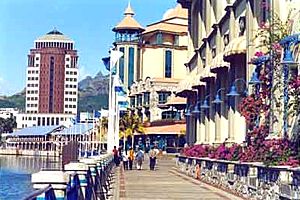 Backed by mountains at the north-western end of the island, the burgeoning capital of Port Louis is a large city (in proportion to the size of Mauritius), though it contains a relatively small percentage of the country's total population. During the day, it bustles with big-city commercial activity - snarling traffic, honking horns and all. By night, in contrast, all is quiet - dare we say 'dead'? - except for the swish new Le Caudan Waterfront, where you'll find a casino, cinemas, shops, bars and restaurants. There's a distinct Muslim area around Muammar El Khadafi Square (appropriately enough at the opposite end of the city from the local hat-tip to the Yanks, John F Kennedy St) and a Chinatown
around Royal St. The city centre is easily covered on foot.
Backed by mountains at the north-western end of the island, the burgeoning capital of Port Louis is a large city (in proportion to the size of Mauritius), though it contains a relatively small percentage of the country's total population. During the day, it bustles with big-city commercial activity - snarling traffic, honking horns and all. By night, in contrast, all is quiet - dare we say 'dead'? - except for the swish new Le Caudan Waterfront, where you'll find a casino, cinemas, shops, bars and restaurants. There's a distinct Muslim area around Muammar El Khadafi Square (appropriately enough at the opposite end of the city from the local hat-tip to the Yanks, John F Kennedy St) and a Chinatown
around Royal St. The city centre is easily covered on foot.
A good place to get a feel for city life is the Port Louis Market, near the water in the heart of downtown. With sections devoted to fruits and vegetables, meats and fish, souvenirs, crafts, clothing and spices, be ready to practise some hard bargaining. While in the neighbourhood, most visitors drop by the Natural History Museum to see a stuffed replica of that 'abnormal member of a group of pigeons', the dodo, which has been extinct since the late 17th century. The museum also houses stuffed representations of several other extinct birds as well as specimens of animals and fish that are still with us. The only other regular exhibitor in the city is the Mauritius Postal Museum,
featuring a collection of Mauritian stamps and assorted philately.
If you're interested in Islamic architecture, stop by Port Louis' oddly located Jummah Mosque, built in the 1850s in the middle of Chinatown, and Fort Adelaide, which so closely resembles a Moorish fortress that locals call it the Citadel. Fort Adelaide is the only one of Port Louis' four British forts that's still accessible and not in ruins; the views from its hilltop, harbourside location are wonderful.
The Lourdes of the Indian Ocean, Père Laval's Shrine is just north-east of the town centre at Ste-Croix. Père Laval - who is said to have converted more than 67,000 people during his 23 years on Mauritius - is remembered with a colourful plaster statue atop his tomb. Pilgrims swear by the statue's healing powers and come in droves to touch it.

|